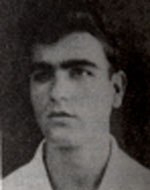Herzl, son of Kamus and Gita, was born in 1942 in Tripoli, Libya, and immigrated to Israel with his parents, brothers and sisters in 1905. In Israel, he studied at the “Amishav” elementary school in Petach Tikvah and continued his high school studies in the kindergarten and nursery school in Petach Tikvah. In addition, he studied graphics and painting at the Technikom vocational school in Tel Aviv. Herzl was born into a large family. When he immigrated to Israel with his family, he was eight years old and easily settled with the children in Beer-Yaakov. He was a nice boy, alert and lively. When he began studying at the Amishav Elementary School in Petach Tikvah, he became a diligent student of both teachers and students. He was passionate, and excelled in painting. After two years of study at the high school for kindergarten teachers, he decided to study painting and graphics. With the encouragement of his parents and with their assistance, he entered the Technikum school and studied painting and graphics there. Every leisure hour he dedicated to painting, and many paintings and drawings he made were in his home and at his parents’ house. “Herzl had a fantastic talent and was accompanied by sensitivity to beauty and aesthetic understanding,” says the family members, “a jarring sign aroused his anger, a pleasant, colorful and modest advertisement aroused his enthusiasm.” Herzl spoke a great deal about the need to improve the quality of life and the great value inherent in the cultivation of beauty. He was one of us, laughed and celebrated with us, knew with us hours of sorrow And cheerful. “He was a strong, handsome, intelligent, mature and serious lad, who was drafted into the IDF in mid-November 1960 and assigned to the Armored Corps. After basic training, he completed a number of courses, including a tank training course, an officers’ course, and an officer training course. He also took a parachuting course and proudly wore the wings of a parachutist. In his unit Herzl was known as a soldier and as a dedicated and responsible commander, and filled various positions of an officer in the Armored Corps. In the winter of 1963 he was released from regular service and placed in a reserve unit. He returned to civilian life and began working as a graphic artist in graphic industries. In his office, he met Miriam, his wife-to-be. When the war broke out in 1967, he was drafted and fought in the Sinai, and when the war ended he was awarded the “Six Day War”. Two weeks later he married his choice. Herzl and Miriam set up their home in Givatayim. In January 1969, their eldest daughter, Galia, was born. “He was not as Simcha as Herzl, he was an exemplary pain, and for long hours he looked at her, in his little Galya, and spoiled her and played with her,” Miriam said. In 1972, Herzl left his work in graphic industries and joined a private enterprise in Tel Aviv. “On his own and in cooperation with his friend, he began to build the business, step by step, patiently and persistently, and sought to integrate art efficiently, in the field of signage in lighting.” In the summer of 1973 he was born to Miriam and Herzl son of, whose name was Amos. Herzl was in full force when he was called back to the weapon. No one imagined that his way of life would be interrupted at once. When the Yom Kippur War broke out, Herzl was called to his company in the Armored Corps. He was sent to the Sinai front and fought there as a tank commander. For two weeks he fought courageously and with exemplary devotion in the braking battles. On October 18, 1973, Lieutenant Herzl was wounded and killed in a missile ambush south of Fayyad. He was laid to rest in the Petah Tikva cemetery. Survived by a wife, daughter and son, parents, brothers and sisters. In a letter of condolence to the bereaved family, the unit commander wrote: “Herzl came to me on the third day of the war, and during the brief period in which we fought together, I learned how courageous and professional he was. Sit downBefore his death, the tank commanded by Herzl was damaged. Despite this injury, he did not give up, worked all night to prepare the tool for re-operation, and joined us the next day at dawn. His death came upon him when he was first in the assault, exposed in the turret. “Herzl’s wife and friends commemorated him by setting up sports facilities for the soccer team in his home.
